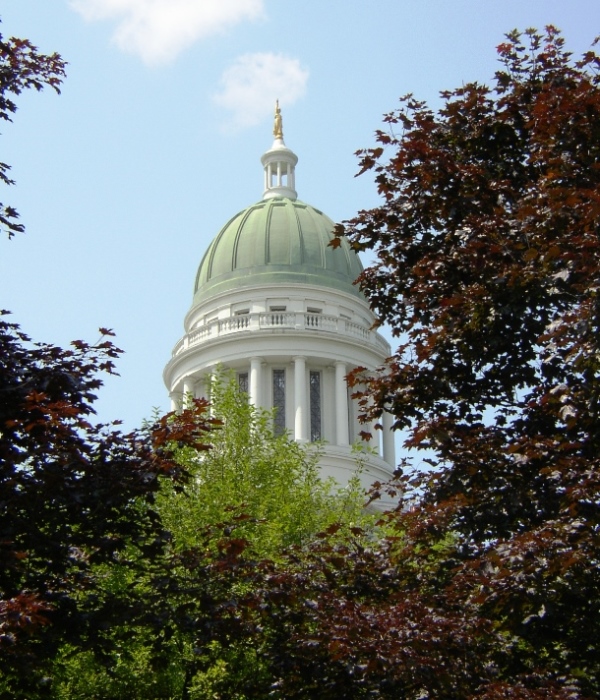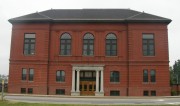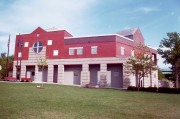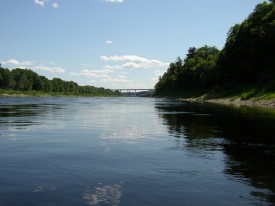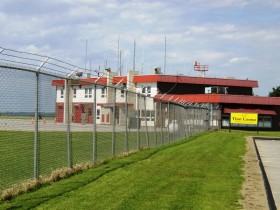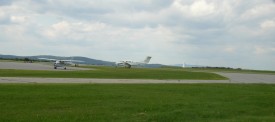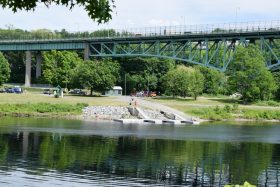| Year | Population |
|---|---|
| 1970 | 21,945 |
| 1980 | 21,819 |
| 1990 | 21,325 |
| 2000 | 18,560 |
| 2010 | 19,136 |
| Geographic Data | |
|---|---|
| N. Latitude | 44:19:50 |
| W. Longitude | 69:43:47 |
| Maine House | Districts 80,85,86 |
| Maine Senate | District 15 |
| Congress | District 1 |
| Area sq. mi. | (total) 58.3 |
| Area sq. mi. | (land) 55.4 |
| Population/s.mi | (land) 344.8 |
County: Kennebec
Total=land+water; Land=land only |
|
The Capitol Dome in Augusta (2004)
[ah-GUS-tah] a City in Kennebec County on the Kennebec River, was incorporated on February 20, 1797, from a portion of Hallowell, as the town of Harrington. Its name was change to Augusta on June 9th of that year. On August 20, 1849, it was incorporated as a city and has been the State Capital since 1832 when the State House was first occupied. Originally known as Cushnoc, it was the site of the Plymouth Pilgrims’ trading post in their Kennebec Patent beginning in 1628.
Although there may have been nearly one hundred inhabitants in the area in 1675, the Second Indian War (1689-1697) forced an exodus. The stone fort of 1713 could not prevent devastation from later wars.
In 1754 the famous Fort Western was constructed and, under the command of Captain James Howard. The secure area attracted trappers and, eventually, permanent settlers.
Bond Brook runs from northwest to southeast across the middle of the city west of the Kennebec, where it enters the river. Touted as “Home of wild Atlantic Salmon,” it was also home to at least two mills powered by its flow. Coombs Mill is upstream on the Leighton Road; the other is downstream close to its confluence with the river.
During the late 19th century labor unions emerged in response to the efforts of the Knights of Labor to enact labor reform laws. The following 1903 list of Augusta labor unions provides an insight into the local economy of the time: Augusta Typographical; Bricklayers, Masons and Plasterers; Cab Drivers; Carders [textile workers]; Carpenters and Joiners; Journeymen Barbers International; Loomfixers [textile workers]; Masons Tenders; Mule Spinners [textile workers]; Painters, Decorators and Paperhangers; Pulp, Sulphite and Papermill Workers; Retail Clerks; Suspender Workers; and Weavers [textile workers].
Augusta is the birthplace of U.S. Representative George Washington Ladd and of U.S. Representative and U.S. Senator Olympia J. Snowe. It was also the long-time home of state legislator, U.S. Representative, and founder of the Kennebec Journal newspaper, Luther Severence. Charles P. Nelson, another U.S. Representative in the mid-20th century, was also a resident of Augusta.
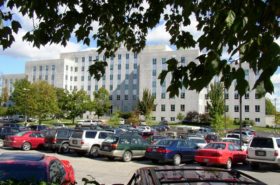
Maine State Office Building in Augusta (2006)
The State government complex, once primarily located on the west side of the Kennebec River near the State House, has expanded on the east side to the area of the former Augusta Mental Health Institute (AMHI), open from 1840 to 2004 when is was replaced by the Riverview Psychiatric Center in that year. The State House and the State Office Building, now named for Governor Burton Cross of Augusta, both had recent extensive renovations, completed in 2001.
The Blaine House, once the home of James G. Blaine, is the official home of Maine’s governors and open for public tours. Augusta is the birthplace of Jean Hawley Gannett, owner of the Portland newspapers, and other media properties. Don Brennan, born here in 1903, played baseball for the New York Yankees 1933-1937, Cincinnati Reds, and New York Giants.
The Augusta State Airport, while owned by the State of Maine, is managed and operated by the City of Augusta. It offers scheduled commercial service and general aviation use.
A capitol area comprehensive plan provides for the renovation and expansion of the State Cultural Building, the third large structure adjacent to the State House and the Office Building.
The Cultural Building houses the Maine State Archives, Maine State Library, and Maine State Museum. Open to the public, they are excellent research resources specializing in Maine history.
Augusta, named for Augusta of Saxe-Gotha, wife of Frederick, Prince of Wales,* is also home to a branch of the University of Maine, to the Augusta Civic Center with a major auditorium, and to Fort Western, a museum and learning center.
The Pine Tree State Arboretum has 200 acres of rolling hills and meadows, mature pine and hardwoods and open woodlands provide a rich variety of colors and a diversity of habitats. Ponds and bird houses attract a variety of wildlife.
The city is the site of a federal Superfund Site created by hazardous waste from the O’Connor Company. The site has been substantially cleaned and secures, but is still monitored by the U.S. Environmental Protection Agency.
Downtown Augusta has been prone to flooding from the Kennebec River in Spring, including the “Great Flood” of 1987, which affected many communities. When the Kennebec behaves, the downtown features boat launch facilities on both the east and west banks of the river. Several upstream communities provide boat launches.
- West Side Dock (2021)
- East Side Boat Launch (2021)
Augusta had one of the recommended “travel homes” in the post World War II guide “The Negro Travelers’ Green Book.” It was the Mrs. Joseph McLean Tourist Home at 16 Drew Street, which served African Americans when many others did not.
Form of Government: Council-Mayor-Manager.
National Register of Historic Places – Augusta
Additional resources
*See Glossary, source number 7.
Augusta: the Capital City of Maine. Portland, Me. Portland Board of Trade. 1912.
Coffin, Edward Seabury. The Untold Story of the Great Kennebec Dam at Augusta. Augusta, Me. E.S. Coffin. 1991.
Nash, Charles Elventon. The History of Augusta: First Settlements and Early Days as a Town, Including the Diary of Mrs. Martha Moore Ballard (1785 to 1812). Salem, Mass. Higginson Book Company. 1997. Reprint of original 1907 edition.
North, James W. The History of Augusta, Maine. Somersworth, N.H. New England History Press. 1981.
Scontras, Charles A. Two Decades of Organized Labor and Labor Politics in Maine 1880-1900. Orono, Me. University of Maine. Bureau of Labor Education. 1969.
Violette, Maurice. The Franco-Americans: A Franco-American’s Chronicle of Historical and Cultural Environment: Augusta Revisited. New York. Vantage Press. c1976.
Violette, Zachary. Winthrop Street, Augusta, Maine: An Architectural and Historical Overview. Augusta, Me. Kennebec Historical Society. 1999.
Writers’ Program (Me.). Augusta-Hallowell on the Kennebec. New York. AMS Press. 1983 Reprint of the original, 1940, from the Federal Writers’ Project.


